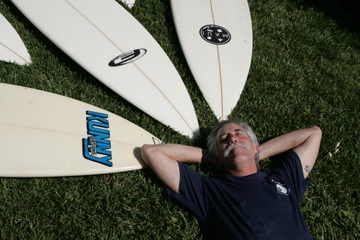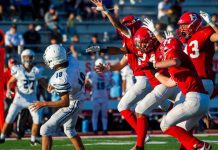
Hollister engineer opens a surfboard repair shop
Hollister may be the birthplace of the American chopper, but
it’s not exactly thought of as a surfing town since it is at least
35 minutes away from the nearest beach.
Hollister engineer opens a surfboard repair shop
Hollister may be the birthplace of the American chopper, but it’s not exactly thought of as a surfing town since it is at least 35 minutes away from the nearest beach.
But don’t tell that to David “Lucky” Waddell, a lifelong surfer who opened up a successful surfboard repair shop two years ago out of his garage.
“I had been repairing surfboards since I was 16,” said Waddell, who is now 49. “I was an electronics engineer but I was tired of getting laid off. And when I was doing that type of work, I never had time to surf anyway. Now, I actually get to go to the beach to meet my clients.”
And that’s where Waddell is most happy.
A native of Southern California, Waddell started body surfing at the age of 5. By the time he was 10, he purchased his first surfboard and has been hooked on the sport ever since.
“I enjoy it because you can do something under your own power,” he said. “You don’t need a machine to help you. Surfing also keeps you physically fit and mentally sharp.”
Although he is an accomplished surfer, Waddell never competed professionally.
“I entered my first contest when I was a teenager, but I was too nervous,” he said. “I’d rather be out there just to have fun and to focus on my mental and physical health, which surfing helps with.”
In fact, Waddell credits surfing as the key to his ability to recover from a serious accident in 1983 that nearly took his right leg. That year he was riding a motorcycle down Harbor Boulevard in Costa Mesa when a truck driver failed to notice him and crashed into his leg. As a result of the crash, Waddell suffered a complex fracture to both his tibia and fibula that was so severe doctors gave him only a 30 percent chance of keeping the leg. Ten months later, he was back surfing again.
“The doctors couldn’t believe it,” Waddell said. “They said I was in such good physical condition from surfing and bicycling that I was able recover quickly. The doctors expected a 10-month recovery.”
Today, he walks with a limp and still has to wear orthopedics for his leg and a gel pad on his foot, but believes that his bicycling, surfing and health-conscious diet is what has allowed him to continue surfing to this day.
“I still ride waves up to 20-feet high,” Waddell said. “I normally surf out at Moss Landing. The waves out there are usually in the 10-15 foot range. Moss Landing has a very good beach break.”
While the surfing has helped keep him healthy, the sport has also caused some health issues. Just a few years ago, Waddell ruptured his right rotator cuff while surfing. Another time, while surfing out at Pleasure Point near Soquel, a swell had come up at about the same time the tide came in too fast, which started to suck him out to sea and into a bunch of rocks that could have killed him before some anonymous person pulled him out of the water and saved his life. Waddell never knew his name.
“The challenge of going out in the water and pitting me against the elements is what I enjoy,” Waddell said. “You have to use your physical and mental skills. I even took up yoga one time to help me with my ability to focus while surfing.”
While the danger of physical injury is always there, Waddell says he never worries about sharks, and won’t surf anything too dangerous like the notorious Maverick’s beach, which is located closer to the San Mateo coastline.
“I’m not that crazy,” he said. “As far as sharks go, they are out there but I’ve never seen a shark in the water. Statistically, it’s more dangerous to drive to the beach than to be attacked by a shark while surfing. It’s about 5,000 to 1 to be killed driving there and 15,000 to 1 to be attacked by a shark. Really the most dangerous thing is surfing in bad weather during a high-surf, high-tide combination. Current and rock is a bad combination.”
Ironically when surfboards hit into rocks it’s good for Waddell’s business.
“Yeah, people hit rocks with their boards but you’d be surprised how much damage happens right in parking lots and in driveways,” Waddell said. “A lot of times people just accidentally drop their board and break it.”
Considering the costs of those boards it’s no wonder his business is booming. The typical short board, a board less than seven feet, runs about $450 while long boards, which run more than nine feet, are usually about $750 a piece.
“I first taught myself how to do fiberglass work when I was a kid,” Waddell said. “The last few years I decided I wanted to make a business out of it.”
Waddell’s shop is called Lucky’s Ding Repair. In addition to surfboards, Waddell is capable of repairing anything from race cars to boats in his shop.
“Now I’m doing a lot of repairs on these wave skis, too,” he said. “Most of my work is by word-of-mouth. I also work with some of the surf shops in the area, too.”
Instead of the old boards ending up in some landfill, Waddell would like to see every board repaired. In some cases he has repaired surfboards that the owners probably would have thrown away in order to give them out as a gift to a child, who may have shown an interest in taking up the sport.
For additional information on Lucky’s Ding Repair, call 637-8680.









